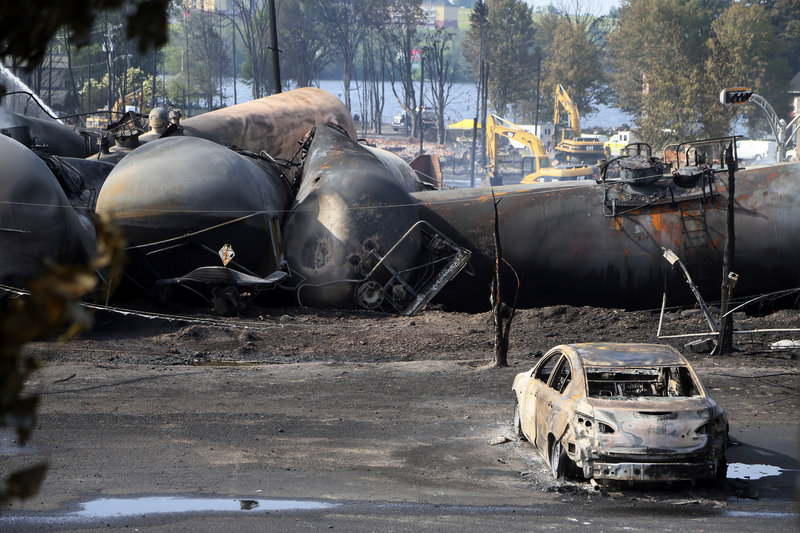The Maine company that owns the runaway train that exploded July 6 in the center of a Quebec town has lost much of its freight business and is struggling financially.
The Montreal, Maine and Atlantic Railway on Tuesday laid off 79 employees, with the workforce in Maine bearing the brunt of the layoffs.
The train disaster, which occurred just 10 miles from the Maine border in the town of Lac-Megantic and killed 50 people, has cut off the company’s rail lines in Maine from the rest of its network in Quebec as well as national railroads that cross the continent.
The disaster essentially has cut the railroad in two.
While its operations in Vermont are unchanged, the railroad no longer can send trains carrying oil tankers through Maine to a refinery in Saint John, New Brunswick. It also no longer can provide manufacturers east of the Lac-Megantic blast zone with a rail connection to the west.
“We have lost a lot of business,” said Ed Burkhardt, CEO of the railroad’s parent company, Rail World Inc. “We don’t need to run many trains. Revenues are way down.”
He added that the layoffs are a temporary measure and that hopes to hire the workers back once revenue rebounds. “We are doing what any company would do,” he said.
Burkhardt said he is unaware of the details of the layoffs and did not know how many workers were laid off in Maine.
The railroad, a relatively small company based in Hermon, owns 512 miles of rail, operates in Maine and Quebec and serves customers in Vermont just south of the Quebec border. The parent company, Rail World Inc., is based in Chicago.
Only 19 of the MM&A’s 80 workers in Quebec are being laid off, according to the provincial branch of the United Steel Workers Union. Two of those employees are managers. That would mean 60 of the company’s employees in Maine — more than half of the Maine workforce — have been laid off.
For MM&A’s customers in Maine, the railroad’s problems pose a logistics challenge for getting their products to market and receiving supplies
It’s also upsetting to see Maine people loose their jobs, said Everett Deschenes, manager of fiber and logistics at Old Town Fuel & Fiber.
“I am very saddened,” he said. “My boys said they were good people to work with.”
Deschenes said the MM&A is still able to deliver wood chips to its plant from suppliers in northern Maine, but the plant now is using Pan Am Railways primarily to ship its product, pulp, to customers to the west. The plant also has begun using trucks for shorter distances.
He said Pan Am Railways should be commended for offering fair shipping rates and not taking advantage of its new rail monopoly.
Cynthia Scarano, executive vice president of Pan Am Railways, said the normally competitive railroads now are cooperating to re-route freight and make sure commerce is not interrupted.
“Everybody is working together as a group to make sure things keep moving through the state,” she said.
Pan Am, which has 2,000 miles of rail in New England, offers connections to the west through Albany, N.Y.
The train that exploded in Lac-Megantic was carrying 72 tanker cars of western oil destined for delivery at a huge refinery in Saint John, owned by Irving Oil Ltd.
While the MM&A route through Lac-Megantic was an important rail line for the company, equal amounts of western crude were being shipped through southern Maine via Pan Am Railway and on Canadian National Railway tracks, according to CBC News.
Oil deliveries on Pan Am through southern Maine are expected to increase.
The St. Lawrence & Atlantic Railway, which operates trains between Portland and Ste.-Rosalie, Quebec, where it connects with the Canadian National Railway, also has reached out to MM&A and has offered help re-routing cars, said the railroad’s president, Mario Brault.
One of the MM&A’s biggest customers is also Lac-Megantic’s largest employer, Tafisa Canada Inc., which manufactures particleboard and thermofused melamine panels.
The factory, which employs more than 300 people, ships 2,500 train cars of particle board annually.
The factory depends on the MM&A to ship its product to markets in the west, but the factory is east of the area of the train disaster, which remains closed while crews work to recover bodes and remove tankers. The area is also considered a crime scene.
Burkhardt, the railroad president, said it’s uncertain how long the area will remain closed and when train traffic can resume.
He said Tasifa and MM&A staff are developing a plan to truck products a short distance and then load them onto railcars west of the disaster site.
He said he said he appreciates that other railroads have offered to help.
“It’s a strange business,” He said. “We are enemies one day and friends the next. … We fight on one thing and cooperate on another.”
Send questions/comments to the editors.



Comments are no longer available on this story